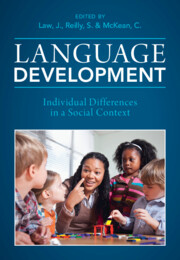Book contents
- Language Development
- Language Development
- Copyright page
- Contents
- Figures
- Tables
- Contributors
- A Tribute to Our Friend, Colleague and Fellow Editor, Professor James Law
- Introduction
- Part One Factors Influencing Language Development
- 3 Genetic Studies of Language Disorders
- 4 Hearing and Language
- 5 Co-occurrence between Language Disorders and Common Conditions in Childhood
- 6 Language and Cognition
- 7 Growing Up in Multilingual Communities
- 8 Parent–Child Interaction and Its Impact on Language Development
- 9 Cognitive Competencies and Signals of Risk
- 10 Creating Equitable Opportunities for Language and Literacy Development in Childhood and Adolescence
- Part Two Continuity and Change
- Part Three Impact, Intervention and Equity
- Index
- References
3 - Genetic Studies of Language Disorders
from Part One - Factors Influencing Language Development
Published online by Cambridge University Press: 11 August 2022
- Language Development
- Language Development
- Copyright page
- Contents
- Figures
- Tables
- Contributors
- A Tribute to Our Friend, Colleague and Fellow Editor, Professor James Law
- Introduction
- Part One Factors Influencing Language Development
- 3 Genetic Studies of Language Disorders
- 4 Hearing and Language
- 5 Co-occurrence between Language Disorders and Common Conditions in Childhood
- 6 Language and Cognition
- 7 Growing Up in Multilingual Communities
- 8 Parent–Child Interaction and Its Impact on Language Development
- 9 Cognitive Competencies and Signals of Risk
- 10 Creating Equitable Opportunities for Language and Literacy Development in Childhood and Adolescence
- Part Two Continuity and Change
- Part Three Impact, Intervention and Equity
- Index
- References
Summary
Developmental language disorder (DLD) is estimated to affect 8 per cent of primary school-aged children, and has lasting impacts on academic achievement and social-emotional and behavioural outcomes. DLD is classified as a severe and persistent impairment in the acquisition, understanding, production or use of language, occurring in the absence of comorbid neurodevelopmental disorder. The phenotype of DLD is well established, yet there is relatively limited understanding of its aetiology. A complex interaction of genetic variants and environmental factors is thought to be the cause. To date, linkage and association analyses have implicated a handful of genes in DLD populations, including CMIP and ATP2C2. While many of these variants are common in DLD, they are not consistently associated with severe language impairment, and many overlap with chromosome regions commonly associated with neurodevelopmental disorders such as intellectual disability. The effects of alternate genetic models such as copy number and rare variants may provide a gateway to understanding the complex genetic pathways of this disorder. Pleiotropy and generalisation are also important considerations in understanding the genetic architecture of DLD. Here we outline the phenotype of DLD and provide an overview of recently identified gene pathways implicated in this disorder.
- Type
- Chapter
- Information
- Language DevelopmentIndividual Differences in a Social Context, pp. 45 - 77Publisher: Cambridge University PressPrint publication year: 2022



